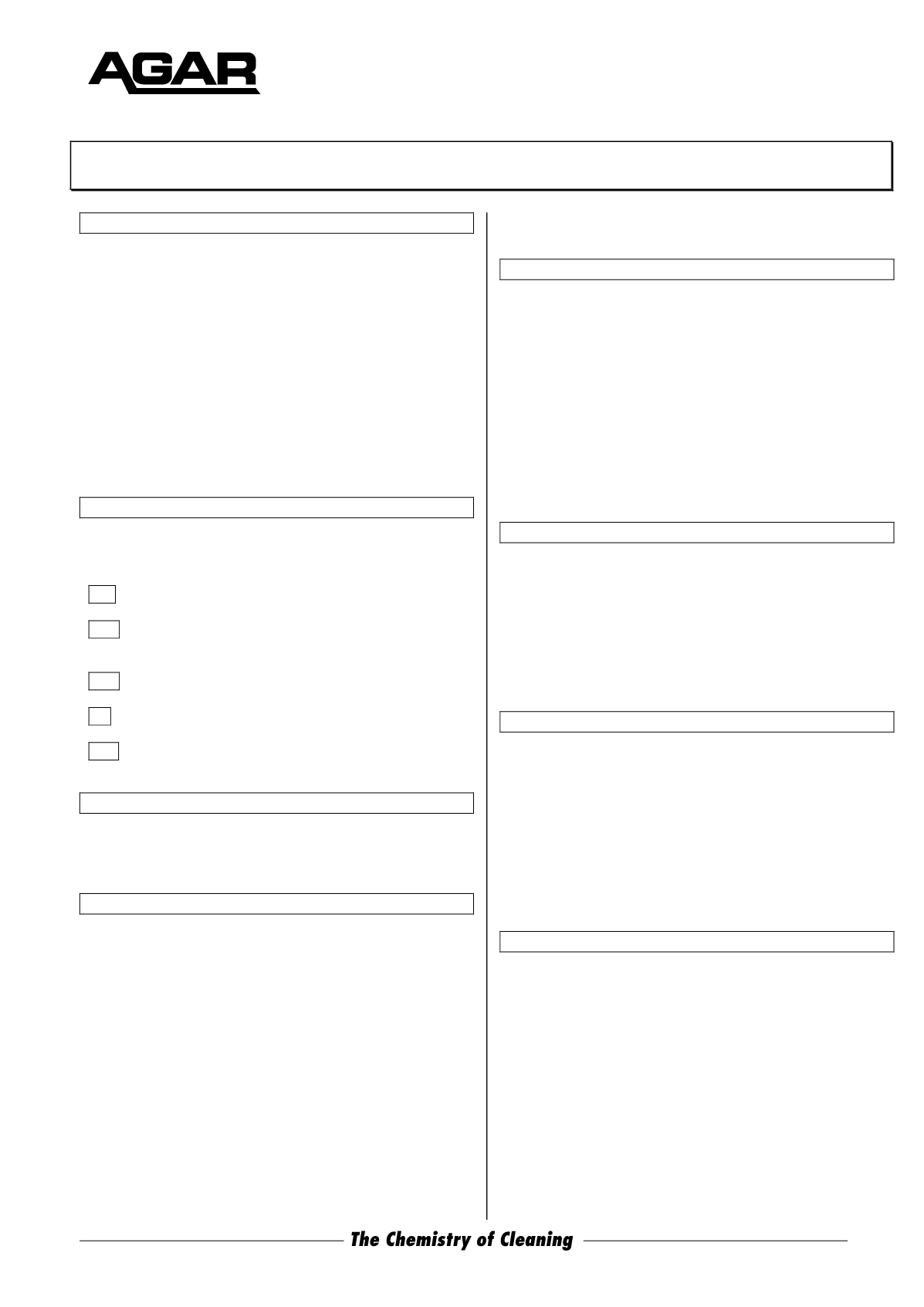

ABN 80 004 726 890
MADE IN AUSTRALIA
VIC 03 9480 3000
NSW 02 9743 6020
SA 08 8293 2020
QLD 07 3205 7244
WA 08 9249 4566
Safety Data Sheet
Issued: April 14, 2011
Page 1 of 2
CARPET SPOTTER ‘B’
1 IDENTIFICATION OF THE MATERIAL AND SUPPLIER
Product Name:
CARPET SPOTTER B
Other Names: Butyl Acetates
Manufacturer's Product Code: CARSB5
Product Use: Carpet stain remover. Cleaning solvent.
COMPANY DETAILS
Company: Agar Cleaning Systems Pty. Ltd.
Address: 12-14 Cope Street, Preston, Vic. 3072
Telephone: 03 9480 3000 Facsimile: 03 9480 5100
Web:
www.agar.com.auAgar SDS are available from this website.
E-mail:
admin@agar.com.auEmergency Telephone Number: 131 126
(Aust wide)
2 HAZARDS IDENTIFICATION
Hazardous according to criteria of Safe Work Australia.
Flammable F.
R10 Flammable.
R66 Repeated exposure may cause skin dryness or
cracking.
R67 Vapours may cause drowsiness or dizziness.
S2 Keep out of reach of children.
S25 Avoid contact with eyes.
3 COMPOSITION / INFORMATION ON INGREDIENTS
Ingredients:
Chemical Entity:
CAS No.:
Proportion:
n-butyl acetate 123-86-4 100%
4 FIRST AID MEASURES
Poisons Information Centre: Phone 131 126
Swallowed: If poisoning occurs, contact a doctor or Poisons
Information Centre. If swallowed, do NOT induce vomiting due
to the hazard of solvent aspiration into the lungs. Rinse mouth
with water. Never give anything by mouth to an unconscious
person.
Eye: Immediately hold the eyes open and wash continuously for
at least 10 minutes with fresh running water. Ensure irrigation
under eyelids by occasionally lifting the upper and lower lids.
Seek medical advice. Removal of contact lenses after an eye
injury should only be undertaken by skilled personnel.
Skin: Remove any contaminated clothing and wash area with
soap and water. Seek medical attention in the event of
irritation.
Inhaled: Remove victim from exposure – avoid becoming a
casualty. Keep patient warm and rested. If breathing has
stopped or becomes laboured give artificial resuscitation.
Qualified person may administer oxygen. Seek medical
advice.
5 FIRE FIGHTING MEASURES
Fire/Explosion Hazard: Carpet Spotter B is highly flammable.
Fire Extinguishing media: Use dry chemical, CO
2
or foam.
Fire Fighting PPE: Fire fighters to wear self-contained breathing
apparatus if risk of exposure to vapour or products of
combustion.
Unusual fire hazards: Highly flammable liquid. May form
flammable vapour mixtures with air. Avoid all ignition sources,
unearthed electrical equipment. Vapour may travel a
considerable distance to source of ignition and flash back.
Heating can cause expansion leading to violent rupture of
containers. If safe to do so, remove drums from path of fire.
Keep drums cool with water spray.
Hazardous products of combustion: Thermal decomposition in a
large fire may yield toxic fumes.
6 ACCIDENTAL RELEASE MEASURES
Eliminate all ignition sources, such as flames, cigarettes,
sparks, within at least 50 metres. Do not touch or walk through
spilled material.
Stop leak if safe to do so. Prevent entry into waterways, drains
or pits. Vapour-suppressing foam may be used to control
vapours. Absorb spill with soil, sand or other non-combustible
material – use clean, non-sparking tools to collect material
and place it in drums for disposal. Water spray may be used
to knock down or divert vapour clouds.
7 HANDLING AND STORAGE
Storage and Transport: Store in a cool, dry place away from
sparks and strong oxidants. Store with all the precautions
required for handling a flammable liquid. Observe State
Regulations concerning the storage and handling of
Dangerous Goods. Keep containers closed when not in use.
Class 3 Flammable Liquids shall not be loaded in the same
vehicle with : Class 1, 2.1, 2.3, 4.2, 5.1, 5.2, 7 substances.
Incompatibility (Materials to avoid for purposes of transport,
handling and storage only): Oxidising agents like liquid chlorine,
concentrated oxygen or sodium hypochlorite.
8 EXPOSURE CONTROLS / PERSONAL PROTECTION
Exposure Standards:
n-butyl acetate: CAS No: 123-86-4
TLV TWA 150 ppm (713 mg/m³)
TLV STEL 200 ppm (950 mg/m³)
[Source: Safe Work Australia HSIS-2011]
Engineering Controls: Mechanical ventilation: flameproof
ventilation (local exhaust and/or general mechanical) is
required if sufficient product is used to generate volumes of
vapour that approach the flammability or TLV limits. No
smoking. Vapour is heavier than air – prevent concentration in
hollows or sumps. DO NOT enter confined spaces where
vapour may have collected.
Personal Protection: Respiratory: Not needed normally. Use
with adequate ventilation.
Please turn to page 2.


















